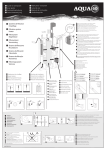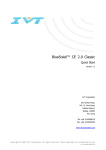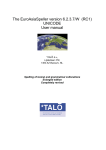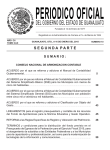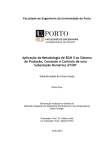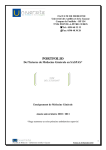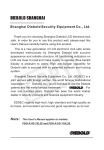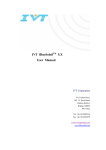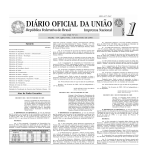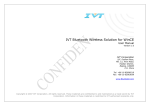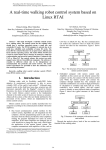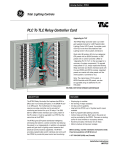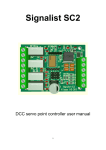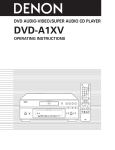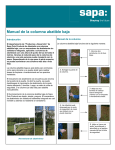Download fulltext
Transcript
Databaserat hjälpsystem för kontrollerat underhåll Computerized Maintenance Management System Niklas Ruud Linköpings University, Machine Design Department of Management and Engineering Examensarbete Institutionen för ekonomisk och industriell utveckling LIU-IEI-TEK-G--09/00142--SE 1 Sammanfattning I det här examens arbetet har implementation av ett underhållsprogram kallat Computerized Maintenance Management System arbetats fram med hjälp av SKF konsulter. Arbetet har pågått i 10 veckor på Sapa Thermal Heat Transfer(Shanghai)Ltd på underhållsavdelningen. Sapa tillverkar och säljer aluminium till den automobila marknaden. Målet har varit att förstå och använda det nya datorsystemet CMMS. Det skall hjälpa Sapa att spara på onödigt underhåll och underlätta beställning av reservdelar, schemalagt underhåll och för att lägga problem och lösningar till problemen i CMMS databasen. Mitt arbete är avgränsat till delar av CMMS. Rapporten är begränsad till delar av CMMS. Kantjusterarens kritiska punkter som är positionsövervakaren och det stora lagret i den vertikala mittenrullen. Jag beskriver vilka fel som kan uppstå och ger rekommendationer till problemen genom att i rapporten skapa olika koncept och ge en förklaring till vad som bör göras. Jag ger en kort introduktion till det nuvarande underhållet på Sapa i Shanghai och hur man uppdaterar databasen genom skapandet av en användarguide ämnad för Sapa. Intervjuer har utförts på Sapas underhållsavdelning med SKF personal och API Pro personal samt ett besök till företaget CNPT i Luoyang som är Sapas varmvalsnings leverantör. Störst hjälpmedel har varit från databasen Citrix där man kunnat inhämta historiska maskindata via programvaran API Pro. Fakta har även inhämtats från internet och internt material. Rapporten utmynnar i ett antal rekommendationer och hjälpmedel för att kunna fortsätta uppdateringen i CMMS för den nya varmvalsen som kommer på plats i oktober. Att kunna optimera underhållet till minsta möjliga komponent för att spara in på tid, pengar och via ett underhållsbibliotek se när det behövs beställas reservdelar. Det är meningen att CMMS skall hjälpa till och sköta underhållet till den grad att produktion skall kunna ha en 90 procentig maskintillgänglighet. 2 Abstract In this thesis have an implementation of a maintenance program called Computerized Maintenance Management System that has been developed together with the personal from SKF. The work has been conducted for 10 weeks at Sapa Thermal Heat Transfer (Shanghai) Ltd on the maintenance department. Sapa manufacture, sell and deliver to the automobile market. The goal has been to understand and learn how to use the new computer system CMMS. It shall help Sapa to save on doing unnecessary maintenance and make it easier to order spare part, scheduled maintenance and to see the problems and the solution the problems in the CMMS database. My report is limited to parts of the CMMS. The edge guides critical points that are the position transducer and the vertical roller bearing. I describe the failures that can occur and recommend some solutions to the problems. With the creation of different concepts, explanations are given to guide you to the right solution. I give a short introduction to the current maintenance in Sapa and how to update the database through the creating of a user manual directed to Sapa. Interviews have been conducted at Sapa maintenance department with SKF and API Pro personal. The biggest helping tool has been from the CMMS there I have been able to read about current problems with the edge guide. Fact has also been taken from the Internet and material provided by Sapa The report shows a few recommendations and helping tools for how to continue the update in the CMMS for the new hot mill. Optimize the maintenance to the smallest component with the goal of saving money and production time. The reason is that CMMS shall contribute to manage the maintenance so much that the machine should have availability above 90 percent. 3 Acknowledgement This thesis is the finishing part of my degree in machine technology at Linköpings University. The thesis was conducted at Sapa Thermal Heat Transfer Ltd in Shanghai, China during the summer of 2009. I would like to thank all people that have helped me during the work progress, especially: Supervisor: Wang Yue Ming Maintenance department in Sapa, Shanghai Supervisor and Examiner: Stig Algstrand Department of engineering and management at Linköpings University Shanghai, China 2009-09-21 Niklas Ruud 4 Explanations of words used in the report RTF = Run to Failure (Reactive Maintenance) PM = Preventive Maintenance EHS = Environment Health and Security PdM = Predictive Maintenance ACM = Availability Centered Maintenance KPI = Key Performance Indicator RCM = Reliability Centered Maintenance SRCM = Streamlined Reliability Centered Maintenance FMEA = Failure Mode and Effect Analysis FMECA = Failure Mode and Effect Criticality Analysis CMMS = Computerized Maintenance Management System CM = Corrective Maintenance NDT = Non Destructive Testing LTA = Logic tree Analysis SPI = Serial Peripheral Interface Bus Un-clad: when the input-material do not have welded material added Clad: when the input material have added material Preheating: Heat the input-material before it goes on the roller table Edge guide: measuring the width and stabilizing the slab into the rollers Work roll: The middle rollers Support rollers: The big outer rollers Roll gap: the opening for the work rollers Entrance roll coil: the upper coil on the materials input side, right side Exit roll coil: the upper coil on the materials output side, left side 5 1. Introduction ............................................................................................................................. 13 1.1 Background ............................................................................................................................. 13 1.2 Purpose .................................................................................................................................... 14 1.3 Limitations .............................................................................................................................. 14 1.4 Goals ........................................................................................................................................ 14 1.5 Error sources .......................................................................................................................... 14 1.6 Structure of the report ........................................................................................................... 14 Chapter 1: Introduction ............................................................................................................... 14 Chapter 2: Company presentation .............................................................................................. 14 Chapter 3: Description about rolling hot mill ............................................................................. 15 Chapter 4: Aluminum ................................................................................................................. 15 Chapter 5: Methodology ............................................................................................................. 15 Chapter 6: Frame of reference .................................................................................................... 15 Chapter 7: Equipment tree .......................................................................................................... 15 Chapter 8, 9, 10 and 11: Result and Recommendations ............................................................. 15 Chapter 12: Final discussion....................................................................................................... 15 2 Company presentation .............................................................................................................. 16 3 Description of the hot rolling mill process .............................................................................. 17 4 Aluminum .................................................................................................................................. 21 4.1 Corrosion .............................................................................................................................. 21 5. Method....................................................................................................................................... 22 5.1 Collection of information ..................................................................................................... 22 6 6 Frame of reference .................................................................................................................... 22 6.1 Maintenance concept.............................................................................................................. 22 6.2 Background ............................................................................................................................. 22 6.3 Maintenance methods ............................................................................................................ 23 6.3.2 Unplanned maintenance .................................................................................................... 23 6.3.1 Preventive maintenance ..................................................................................................... 24 6.3.3 Condition based maintenance ............................................................................................ 25 6.4 Sapas maintenance ................................................................................................................. 26 6.4.1 Control of spare parts ........................................................................................................ 26 6.4.2 Preventive maintenance ..................................................................................................... 26 6.4.3 Planned maintenance ......................................................................................................... 26 6.4.4 Daily inspections ............................................................................................................... 27 6.4.5 Lubrication......................................................................................................................... 27 6.4.6 Unplanned stops ................................................................................................................ 27 6.4.7 Out sourcing ...................................................................................................................... 27 6.4.10 Technical service and calibration inspections ................................................................. 27 6.5 Measuring methods ................................................................................................................ 28 6.5.1 Thermograph ..................................................................................................................... 28 6.5.2 Vibration monitoring ......................................................................................................... 28 6.5.3 Oil analysis ........................................................................................................................ 28 6.6 Maintenance system ............................................................................................................... 29 6.6.1 ACM .................................................................................................................................. 30 6.6.2 KPI ..................................................................................................................................... 30 7 6.6.3 PdM ................................................................................................................................... 31 6.6.4 RCM .................................................................................................................................. 32 6.6.5 SRCM ................................................................................................................................ 33 6.6.6 FMEA ................................................................................................................................ 34 6.6.7 FMECA ............................................................................................................................. 35 6.6.8 CMMS ............................................................................................................................... 36 7 Equipment tree .......................................................................................................................... 37 7.1 The software API Pro ........................................................................................................... 37 Summary ............................................................................................................................. 37 8 Result and Recommendations .................................................................................................. 38 8.1 Instruction guide for how to set up CMMS with API Pro .................................................... 38 8.1.2 API TEST 1# simulating an abnormal pump pressure ...................................................... 43 Summary: ............................................................................................................................ 47 8.2 Edge Guide .............................................................................................................................. 48 8.2.1 Function ............................................................................................................................. 48 8.2.2 Position reference .............................................................................................................. 48 8.2.3 Critical components ........................................................................................................... 49 9. Bearing ..................................................................................................................................... 50 9.1 Failures and causes ............................................................................................................... 50 9.3 Current bearing observations #1 ........................................................................................... 51 9.4 Current bearing observations 2# ........................................................................................... 52 9.5 Bearing equipment control ................................................................................................... 56 10 Vertical roller........................................................................................................................... 57 8 10.1 Current bearing/system: spherical roller bearing................................................................ 57 10.2 Concept suggestion 1# CARB-bearing............................................................................... 58 10.3 Concept suggestion2#: cylindrical roller bearing ............................................................... 59 Summary ............................................................................................................................. 60 Conclusion ........................................................................................................................... 62 11 Position transducer ................................................................................................................. 63 11.1 Failures and causes ............................................................................................................. 64 Summary: ............................................................................................................................ 64 Conclusion ........................................................................................................................... 64 12 Final discussion ........................................................................................................................ 65 13 References ................................................................................................................................ 66 13.1 Internet ................................................................................................................................ 66 13.2 Intern material..................................................................................................................... 66 13.3 Picture sources .................................................................................................................... 66 14 Thanks to: ................................................................................................................................ 67 15 Attached document ................................................................................................................. 68 9 List of Figures 2.1 Sapa’s picture 14 3.1 Picture of slab loads to the roller table 15 3.2 Picture of the roller table and the system area 15 3.3 Picture of the entrance side 15 3.4 Side view of the system with visible bottom and top adjust screw 16 3.5 Side view of the system with visible lubrication and cooling device 16 3.6 Picture of the coupling 17 3.7 Picture of the engines 17 3.8 Picture of the technical performance for the new hot mill 17 3.9 Picture of the technical performance for the current hot mill 18 3.10 Total view of the new hot mill, top view 19 3.11: Model of the basic function for the hot mill machine 17 4.1 Model of the chemical FCC structure for aluminum 20 6.1 Bathtub curve, preventive maintenance 23 6.2 Condition based maintenance benefit schedule 24 6.4 Model of the predictive maintenance flow process 30 6.5 Model of the SRCM process 33 6.6 Model of the FMECA process 34 6.7 Model of the general CMMS process 36 7.1 Picture of the equipment tree built up in API Pro 37 8.1 Picture of the maintenance menu 39 10 8.2 Picture of the work-order main tab 40 8.3 Picture of the work-order description tab 43 8.4 Picture of the equipment tree in API Pro 44 8.5 Picture of the supplier tree in API Pro 45 8.6 Picture of the failures in API Pro 45 8.7 Picture of the causes in API Pro 46 8.8 Picture of the work-order window in API Pro 46 8.9 Picture of the main maintenance window, step 3; engineer work-order window 47 8.10 Picture of the work-order storage in API Pro 47 8.11 Picture on how to start the selected work-order 48 8.12 Picture on the feed-back window in API Pro 49 8.13 Picture of the edge guide function 50 8.14 Picture of the edge guide equipment tree 50 9.1 Picture on the current vertical roller bearing, spherical bearing 52 9.2 Diagram show the pressure and velocity relation for the bearing 52 9.3 Model of the slab expanding 54 9.4 Model of the upper and lower bearing position with the slab thickness 54 9.5 Diagram of the different in temperature between upper and lower bearing 55 9.6 Diagram of the bearing lifetime 55 10.1 Spherical bearing from the SKF catalog 58 10.2 CARB-bearing from the SKF catalog 59 10.3 Cylindrical bearing from the SKF catalog 60 10.4 Diagram showing difference in nominal bearing lifetime 62 11 10.5 Diagram showing each bearings lifetime 62 10.6 Diagram of the price for each bearing 63 10.7 Drawing of the position transducer 64 List of tables 6.3 Picture of the statistic for a machine availability over 90 percent 29 8.1 Shows what job that correlates with which maintenance methods 42 12 1. Introduction 1.1 Background Hot mills have a great technical meaning to the society of today. The reason for using hot mills is to reduce the thickness and the corn structure in the material when it goes through parallel driven work rollers. Rolled metal is an important material in modern manufacturing. Rolled products exist in our daily life. The companies today that manufacture material to customers in all imaginable industries demands that the maintenance is being taken care of on a very advanced level with all possible solutions and systems to make sure that it does not occur a failure that could have been avoided. The systems need to be reliable and the manuals are systemized to be able to troubleshot future problems. Condition based maintenance has come to be a positive trend the last years. The best maintenance solutions are used everywhere but good applications is still in demand for well integrated systems in order to get the best economic solutions. Sapa are now aiming for world class condition based maintenance through the application of “Computerized Maintenance Management System” and a project called “Asset Management Analysis” which shall carry out the best maintenance solutions to some certain critical points based on “Reliability Centered Maintenance Analysis”. This thesis main focus is on the new hot mill that is in the “FAZHAN” project. The work is limited to parts of the CMMS. A more deeply study in the edge guides critical points, which has been the position transducer and the bearings in the vertical roller. 13 1.2 Purpose The purpose of this thesis is to help Sapa collect necessary information about the critical device with assistance from SKF, API Pro and the people working in the maintenance department in Sapa. Further on in CMMS seek potential risk zones in the maintenance. Focus has been on the new hot mill that is in the “FAZHAN” project. With help of RCM analyze and test equipment in an economic manner. This shall contribute to a more effective plant when it comes to security, operations and costs. 1.3 Limitations The limitations are within the hot mills equipment that is seen as critical to cost efficiency. With help from CMMS more deeply study and analyze the problem with the edge guide. 1.4 Goals The goal for this thesis is to understand CMMS and through RCM test the equipment that is critical, calculate the cost and give recommendations on improvement if it is financially possible. 1.5 Error sources Most of my sources come from the Internet so this information cannot be 100 percent accurate, since no test has been carried out. Much are company material from Sapa, SKF, API Pro and CNPT, Which has been in mandarin Chinese, so much work has been undertaken through interviews and document translations. 1.6 Structure of the report Description of the different parts of what the report includes so people can chose to read what they are interested in. People with a general interest in Sapa can read the whole report while people with more technical interest can start reading at chapter 8. Chapter 1: Introduction Give a short description of the purpose of the report and what limitations have been set. Chapter 2: Company presentation Talk little about what Sapa Thermal Heat Transfer is doing and a little about the company history. 14 Chapter 3: Description about rolling hot mill Talk briefly about how a rolling mill machine works, and about the hot mills usage areas, the most important components and functions. Chapter 4: Aluminum Talk about aluminum physical properties and usage areas. Chapter 5: Methodology Talk about how the work process was planned. Describe where fact comes from. Working structure with the report from my thesis meetings where questions and how the work should continue have been discussed. Chapter 6: Frame of reference In this chapter material from the Internet and company material has been used to continue the work. Talk about what maintenance methods are on the market. What maintenance system, software and methods that is used to make the maintenance more efficient. Chapter 7: Equipment tree Discuss briefly the equipment tree that is created in Citrix with the API Pro software and showing the implementation of CMMS. Chapter 8, 9, 10 and 11: Result and Recommendations Discuss the problem that is occurring in Sapa and how to solve them. Every problem has its own conclusion. Depending on what problem is occurring there is always a way to solve or find another solution that can minimize the problem and, the cost. Chapter 12: Final discussion Here I do the final discussion about my work in Sapa and share some thoughts about how Sapa could use this report. 15 2 Company presentation Sapa Thermal Heat Transfer (Shanghai) Ltd is a daughter company to Sapa (Sweden). The only company in the world working only with rolled aluminum to produce heat exchangers to the automotive industry. Production is in Sweden, China, Belgium, Germany, Holland, USA and Mexico. In Shanghai the production started in 1999 and has throughout the years, grown bigger to face the expanding market in Asia. Sapa (Shanghai) now have around 1200 people employees. Scandinavian aluminum profiles AB started the first factory in Vetlanda in the year 1963. In 1967, Sapa sold their first aluminum profiles. From 1979 to -1971, Sapa Spont was created, and started to manufacture aluminum constructions for the building sector. The first factory that opened outside of Sweden was stationed in Holland. In 1976 Sapa was bought by Gränges Aluminum. In 1980 Gränges Aluminum bought by Electrolux. Gränges Aluminum was introduced to the Stockholm stocks but was denoted eight years later by the Norwegian company Orkla Asa who succeeded to save the company. Sapa Profiles AB is a part of the Profiles North Europe in the Sapa Holding AB concern which also includes Sapa Building Systems and Sapa Thermal Heat Transfer. [1] Figure 2.1: Sapa’s picture 16 3 Description of the hot rolling mill process Hot rolling means rolling over the recrystallization temperature. Hot rolling is a hot metalworking process where large pieces of metal, such as slabs or billets, are heated above their recrystallization temperature and then deformed between rollers to form thinner cross sections. The hot mill temperature is usually less when rolling material as aluminum and copper. [5] The slab is preheated to 510 Celsius with a weight of 6.5 ton and taken to the roller table (see fig 3.1). The slab thickness is 410 millimeter. Two different slab materials are used, depending on the wanted properties. The slabs are called “un-clad” and “clad”. Clad means that welded material is combined with the aluminum to reach the right properties. Figure 3.1 Figure 3.2 Figure 3.3 The slab is coming to the edge guide to measure the slab width(see fig 3.2) and then starting the process of decrease the thickness and by that the slab is growing its proporsions both in length and width. The cooling is always on to reduce the heat spread that work rollers get from friction between the slab and rollers. This procedure is repeating itself until the first coiling pass is reached. When the thickness is down to 12.5 millimeter the material is to long for the roller table. Then we need to receive support from the roller coils(see fig 3.3) on the entrance and exit sides, at the last coilingpass the slab are rolled into a coil on the exit side. With a final thickness of 4.2 millimeter. 17 Figure 3.4 Figure 3.5 The top rollers force creates a plastic deformation on the strip; this reduces the thickness but increases the length and the width. Here on the new hot mill we have four rollers. Two small in the middle are called working rollers and the other two big ones are called supporting rollers. The middle rollers have a little diameter to create low rolling forces and the two other rollers is called support rollers and usually have a bigger diameter and take the force that creates during the rolling so that the bending from the working rollers is decreased and then creating an even material thickness through all the surface. The top support roller is adjusted with an adjustment screw; (see fig 3.4) the bottom support roller is just for fine adjustments. In the middle, we have the cooling device on both sides to reduce the heat from spreading and lubrication on the lower working roller to reduce the friction (see fig 3.5). 1) Cooling system, (see fig 3.4) 2) Lubrication, (see fig 3.4) 3) Top adjusts screw, roll gap adjuster, (see fig 3.5) 4) Bottom adjust screw, (see fig 3.5) 18 Figure 3.6 Figure 3.7 Four engines are visible(see fig 3.7), each on 1600 kW, the engines are connected to the transmission and transferring the force to an axle which controls the working rollers.(see fig 3.6) The engines are in a series and working together, depending if the material is on the input or the output side. The current hot mill only has three engines that are weaker, which stops you from shorten the time for finishing of a coil. With the new hot mill, you have the advantage to do more individual adjustments since the work rollers are not depending on each other (see attachment 15.7). Figure 3.11: Model of the basic function for the hot mill machine 19 Figure 3.10: Total view of the new hot mill, top view 1) Engine 2) Gearbox 3) Coupling 4) Work roller 5) Tool for switching rollers 6) Roller table 7) Pinch roller 8) Coiler 20 4 Aluminum Aluminum is soft light metal that is silver to gray in the color. Aluminum is a very good leader for heat and electricity. Pure aluminum has yield strength of 7-11 Mpa while alloy has yield strength of 200-600 Mpa. Density and the module of elasticity is a third of steel. It is ductile and can with advantage be processed with cutting, and casting. Aluminum atoms are fixed in a centered surface cubic diffraction (FCC). (See fig 4.1) Properties that makes aluminum to such a good material: Low weight and high strength Resist corrosion Flexible Aluminum can be reused all the time without losing the properties. Reusing only demands 5% of the aluminums total energy. Sapa has recycling facilities around the world. 50% of Sapas production is based on reused aluminum. Figure 4.1: Model of the FCC aluminum chemical structure 4.1 Corrosion Aluminum is often spoken about as a non corrosive metal but that is wrong. Aluminum is only non corrosive in the pH interval pH4 to pH9 since it is producing a protective oil film that protects the material. Alloys is corrosive faster than pure aluminum and faster if it includes copper. At contact with another metal corrosion can happen if the environment is moistly or if the protecting oil film has been worn out as a matter of friction. [7] 21 5. Method 5.1 Collection of information Much of the information has been coming from company documents and discussions with SKF personal who has been stationed at Sapa during the time with this thesis. Interviews have also been conducted on the maintenance department. A visit to the supplier CNPT in Luoyang, China was conducted there interviews and discussion about drawings of the new hot mill was made. Internet has also been used to find relevant pictures and facts about maintenance systems and maintenance methodology. [3], [4], [6] (see attachment 15.3 for the report time plan) 6 Frame of reference 6.1 Maintenance concept Sapa have different maintenance methods, the traditional methods are called preventive maintenance and unplanned maintenance. Sapa also have conditioned based maintenance which is a little complex but very useful for the big industries that are in a need of high control in the machine park. 6.2 Background Machines have through all times been in a need of maintenance. If it is an expensive machine, more knowledge about maintenance methods is needed to select right competence. Maintenance is used to maintain the machines function, quality and availability. Maintenance is the biggest cost a machine has so to choose the right maintenance for each machine is a big challenge that is why we need good knowledge in that area. Bad maintenance is not just too little maintenance is also too much since it creates unnecessary costs. As soon as you perform maintenance it adds costs in downtime, man hours and spare parts. The biggest reason for this is that not enough information has been collected so that decisions about when, how and what could be done in the best cost-efficient way to perform maintenance for each selected machine. 22 6.3 Maintenance methods 6.3.2 Unplanned maintenance Unplanned maintenance also called “run to failure”. This type of maintenance many know as crisis maintenance or hysterical maintenance. This was the form of maintenance used many years ago. The cost for this maintenance method is rather expensive due to unplanned stops, damaged machine parts and overtime costs. When using unplanned maintenance it is hard to control the actual machine status, and cannot predict what needs to be replaced or repaired when it malfunctions. This leads to chaotic maintenance; if cannot plan the need of maintenance it is impossible to predict the status for all the parts. Run to failure should be a small part in a modern maintenance program with the exception in the machine park almost consists of the same machines that are not expensive to replace or repair. Then a machine breakdown it should be fixed as soon as possible so that the production line does not suffer big losses in productivity. Repair the machine WHEN it breaks down, using unplanned maintenance gives: High costs Unplanned machine stops Over time 23 6.3.1 Preventive maintenance The best way to avoid failure is to prevent or eliminate them by using systemized troubleshooting. Damage on person and property must be avoided; risk analysis gives the answer about the biggest risks. Status control and surveillance areas are modern technologies that make the maintenance more efficient. To achieve world-class maintenance (WCM) the technology must be used in the right way and at the right point. The basic for the preventive maintenance is to find new technological solutions, use innovative material or different material combinations. This can be the key to a long lifetime. High Availability requires that spare parts are available and the delivery time is short. In the case failure are visible it is important to fix them as soon as possible. [3] Figure 6.1: Bathtub curve – Preventive maintenance Repair the machine BEFORE it breaks down, preventive maintenance gives: Planned Scheduled Organised Preventive 24 6.3.3 Condition based maintenance Condition based maintenance was introduced to maintain the equipment in the right time. It is based on using the machine data to prioritize and optimize the maintenance. Using the condition maintenance surveillance system gives the status of the equipment and only gives an alarm when it really needs maintenance. The development the latest years have led to the insight that the maintenance personal with guidance of condition based maintenance was able to decide very accurate when a component needed to be replaced or repaired. This is the right maintenance since it gives cost savings in spare parts, machine stop time and the time it takes to do maintenance on a component or equipment. [4] Figure 6.2: Condition based maintenance benefit schedule Condition based maintenance gives us: Predictible failure system Elimination of failures New creations The products lifetime will be longer Reduced working load 25 6.4 Sapas maintenance 6.4.1 Control of spare parts The spare parts are stored in a special storage that holds four different parts: Spare parts Personal equipment including security and hygiene Waist material Other material that hasn’t any relation to the machine spare parts The cost for the parts is maintained by each department and reported to the financial office. 6.4.2 Preventive maintenance Sapa has time based preventive maintenance even condition based preventive maintenance, but it is mainly controlled by thermograph, oil analysis and vibration monitoring. Sapa even has a lot of maintenance including unplanned stops. Much work is now going on with enhanced maintenance that is carried out in cooperation with the project and maintenance department. All maintenance information is written down about any unplanned stops and discussing why it happened and what to do to not repeat the problem. 6.4.3 Planned maintenance Most of the maintenance is done through planned stops, each machine has a schedule of what the planned stops should include, could be all from just lubrication, changing a machine part or a bigger reparation. Sapa have planned stops every week for 8 hours. The planned stops is divided in four different categories Computer based at preventive maintenance Report if something seems wrong at the daily inspection Requirements from the project or maintenance department are meant to be followed If better maintenance is conducted the maintenance engineers shall instruct the operators 26 6.4.4 Daily inspections Sapa have a computer platform that inspects abnormal findings and is controlled daily by the maintenance operator. The controlling parameters are: Machine parameters Abnormal findings shall be reported to the engineers in time Collecting of data is included in the work order 6.4.5 Lubrication Lubrication is done by the maintenance operator, and the schedule tells what needs to be lubricated 6.4.6 Unplanned stops It is still occurring unplanned stops but not to that high level. Maintenance operators are good at reporting the stops characteristics, which is including; Start time, “the time it took to repair”, stop time. If any spare part was replaced it shall be reported and same time a short comment about what could have been the reason to the failure. 6.4.7 Out sourcing Sapa receive help from professional work labor when it comes to some certain points, to do out sourcing is both flexible and economic because it is only requested when Sapa cannot manage it. Sapa do not need to count the cost for train personal. That is an expensive process and would not reach up to the level of what a professional firm can offer since the different out-sourcing firms are experts in what they do. 6.4.10 Technical service and calibration inspections Sapa have calibration inspections that are done by the calibration engineers. When they find a failure in the calibration they call the calibration engineer who decides if the equipment should go for repair or be replaced. The calibration points are now in Sapa: Motor inspection Oil analysis Thermograph Vibration monitoring 27 6.5 Measuring methods Nondestructive testing (NDT) is the name for a group of analysis techniques that is used in different industries to control the material properties, components or a system without damage the measuring object. 6.5.1 Thermograph With thermo graphic pictures it is easier see the overheated areas. It is good helping tool to avoid premature failure on equipment and components. Thermograph helps the engineer to find both heat and cooling leakage to easier optimize the cooling and heating on equipment and components. 6.5.2 Vibration monitoring The most common method for rotation equipment is called vibration monitoring. Vibration monitoring helps to find different failures in the machine. Vibration monitoring helps to avoid expensive machine problem. It is most useful to use in high speed rotational equipment and will let the user analyze and evaluate the equipments status and condition. 6.5.3 Oil analysis Oil analysis is a gathering of lubrication properties and the oils worn-out. Oil analysis is done with preventive maintenance to gather information about the oil status and the machine condition. By following up oil samples from the machine can give savings in reparation cost. Oil analysis is divided in three different categories Analysis of the oil properties Analysis of the oils different substances Analysis of the machine worn out 28 6.6 Maintenance system If a bearing in a gearbox is damaged it can crash the whole gearbox which will lead to high costs that was not predicted. Companies cannot afford this cost since it cannot be predicted and this kind of things can take longtime to reinstall and usually companies’ do not have the budget nor the time since pressure comes from customer’s deadline and budget. To maintain a machine park without having a breakdown is usually the big work load for the maintenance engineers. Preventive maintenance is easy to maintain if using a check list with parts that needs maintenance, often time based maintenance schedule. To put time and money on preventive maintenance is an investment not a cost. Companies that let a machine run to failure is not calculating the high cost it will give in the shape of production losses, increased reparation costs and crisis in the leadership. It is just to think, the machine needs to be repaired! Maintenance engineers just need to think in the right direction. Controlling equipment without using too much workers the companies can implement a maintenance program that help to control machine parts condition so the engineers can change them just before they come to failure, it can be seen as a bridge between preventive maintenance and reparation. 29 6.6.1 ACM Availability centered maintenance (ACM).A tool that can communicate through Computerized Maintenance Management System (CMMS). It is an analytic tool that helps out to choose what strategy should be used than analytical data adds to the INPUT to plan maintenance on plants and machines. 6.6.2 KPI Key Performance Indicators (KPI) is financially measuring methods to decide the success of a company or an organization. It is talking about future goals, to have control of a company’s key indicators is a technique called “Business Intelligence techniques” to see how an organization status and to plan goals and probabilities to reach future goals. The reality surveillance of KPI is more known as “Business Activity Monitoring (BAM) BAM is used to measure and discuss the problems that relate to development of leadership, service and the satisfaction factor. KPI’s main assignment is to help with the future goals, especially when it comes to reaching the unreachable goals due to lack of experience. [11] Table 6.3: Machine availability with a 90% target 30 6.6.3 PdM Predictive Maintenance (PdM) does not tell what the failure is just when it will occur. It is usually a much cheaper alternative than run the machine to failure. Machine service includes rotational equipment and stationary plant. Figure 6.4: A model of the predictive maintenance flow process 31 6.6.4 RCM The RCM process says that it is mainly three potential risks then evaluates failures in the equipment: Securityrisk Risk against the machines processes and operations Economic risk when it comes to the budget Reliability Centered Maintenance (RCM) is one kind of modern developed maintenance then it comes to identifying risk in the most cost efficient way. It shows the cost efficient solutions for failure on the most expensive and complex equipment and components. RCM is a systematized working procedure when it comes to planning maintenance in a cost efficient way to keep the important functions for machinery and equipment. This makes the job easier for the engineers since the work can be monitored and information is available about how longtime a machine part will last. This leads to that the probability calculations can be handed out. The machine can show a Failure Mode Effect Criticality Analysis (see fig.6.6). The most necessary functions get identified and the common machine parameters are checked. The consequences at failure are shown and the program warns with different levels of security, which are depending on the components importance in the system in relation to the costs in run-to-failure. Equipment that does not bring down the big costs at run to failure and does not threat other components does not consider a risk moment. [6] 32 6.6.5 SRCM Streamlined Reliability Centered Maintenance (SRCM) is a more updated system that focuses on effective cost analysis. A process that is using RCM methods and also gives security warning then economy and EHS (Environment Health and Security) comes to the critical factors by application of cost efficient maintenance. Figure 6.5: A model of the SRCM process 33 Differences in the classical/traditional RCM against SRCM RCM analyze all failure modes for both local systems and the plants every failure effect while SRCM just analyze main failure and costs. RCM analyze every failure mode and hand out solutions to the problem while SRCM only analyze the reason for the failure involving the critical components. RCM hand out maintenance schedule for jobs that often are unnecessary since it usually does not lead to a problem while SRCM does not if it is not cost efficient. 6.6.6 FMEA A Failure Modes and Effect Analysis (FMEA) is a procedure to analyze failure modes from a system and be able to detect the level of damage that can happen to the system if no consideration is taken to the failure mode. Failure modes are defects in a process, then failure modes affects the customer then it can be considered a potential or actual failure. Effect Analysis gives the consequences at the failure Failure mode: Describe the failure and why it occurred Failure effect: Messages about the consequence with a failure mode on a process, a products function or status Indenture levels: Identifies the complexity a product has, highest complexity is graded with”1” and decreasing upwards. Local effect: Consequences of findings on analysis Next higher level effect: Messages about the consequences when nothing has been done about the failure mode. End effect: The Damage effect on a product with highest complexity Failure cause: Design defects in a process, quality or some part of an application that is the main cause to the big complex defects Severity: The majority of a defect from an equipment or system, a description of the biggest possible damage and same time the level of complexity of the damage. In a FMEA the level of damage is prioritized due to the damage that can occur, repetitive and how easy it can be discovered. FMEA is a lifecycle program that follows a products birth until it is time to scrap it. The purpose is just to eliminate or reduce the failures. [2] 34 6.6.7 FMECA Failure Mode Effect and Criticality Analysis (FMECA) have an added function to the usually FMEA. FMECA are using criticality analysis, plot probability of failure against consequences of cost. FMECA shows the equipment with the highest probability to failure and what the consequence. 6.6: Model of the FMECA process 35 6.6.8 CMMS Computerized Maintenance Management System (CMMS) is software that contains information about company’s maintenance operations. This is useful to help the maintenance workers handle their job more efficient. To know where the spare part is located in the factory or to calculate the cost of maintenance for some certain machine part will lead to better maintenance control. (See attachments 15.4, 15.5) CMMS platform even helps saving data so you can go back and see what date that certain part was replaced, repaired and who was responsible for the job. CMMS is used by companies that have a high standard on their maintenance. There is some different software on the market now but general CMMS software handle these different services. Figure 6.7: Model of the general CMMS process Word order: Scheduled job, material reservation, savings of earlier costs and track relevant information. Example is reason for the problem, machine stop time and future recommendations. Preventive maintenance (PM): keep track on PM and INS job, which includes a checklist, list on material that is needed. CMMS schedules PM jobs automatic based on the schedule. Availability control: Saving of data about equipment, specifications, warranty information, service contact, and date of purchase, lifetime and other things that can be helping the maintenance engineers in handling their job more efficient. 36 7 Equipment tree The equipment tree is built up with API Pro. It is an easy way for the operators to handle equipment failures. It is based on current documents and known failures through interviews and discussing with the people from the project and maintenance department. The equipment tree shows the main part all the way out to the single component. The creation of this tree makes it easier see how the components are linked to its position. The main focus is on the CMMS critical components in the hot mills edge guide but in the equipment tree an overlook of the hot mills all components in the mill machine can be made easier. Figure 7.1: Picture of the equipment tree build up in the API Pro 7.1 The software API Pro API stands for Analysis, Planning and Information. A useful tool when it comes to organize and setup big plants, helping companies to easier control the maintenance by remembering important data and carry out schedules. Summary Sometimes it can be hard for the operators to find the components that are having a failure, where is the component located? Since the operators are moving around in the different workshops; cold mill, hot mill, slitting and casting. Recommendations is that each work shop area have an equipment tree description like this so if the system gives a failure to the motor fan in the wipe off system for the hot mill, and if the operator cannot find it the operator can take help from the equipment tree and then see that he have to look in the mill machine/wipe off device/ motor fan. This can save Sapas maintenance engineers time for carry out other more important maintenance problem. (See attachment 15.6) 37 8 Result and Recommendations 8.1 Instruction guide for how to set up CMMS with API Pro The most difficult part in setting up data in the CMMS is getting the data. Without any data it would be unnecessary to even think of implementation since the collected documents is the heart in CMMS. The data is collected from the maintenance engineers and the data has been written down through years of experienced maintenance and operations for each part of the hot mill. Engineers have been working many years and written down occurring failures, what did they do to solve it? Was it better to change the part or was it ok just to repair it? Which types of maintenance for each part was preferred and how long time did it take to repair,-replace? This guide will explain how to set up the data that is collected in maintenance department and hope this shall make it easier through future machine implementation to CMMS here in Sapa Thermal Heat Transfer(Shanghai) Ltd. First a short explanation about the information fields and then an example are made for a machinery parts that we can simulate are having a failure. A CMP work order will be simulated from the maintenance operators and then the engineer will find the work order and approve the selected job and make sure it will be done in correct way by supervision if the job is very technical if not, supervising is considered unnecessary. The problem refers to the machine tree that was built up earlier. Figure 8.1: Enter the “Maintenance menu” and select "Work order" A planned maintenance job may be “planned corrective”, “preventive”, “Condition based” or an “inspection”. The difference between these job types is that the PM jobs, Inspection jobs and other jobs can be repetitive (periodical). The Planned corrective job and the CBM job is done only once and will when it is completed disappear from the job planning system. 38 Figure 8.2: Work order- main tab, by clicking on new, the operators execute a new work order. Work Order Key The work order key is created automatically by the system. A prefix and number of digits can be defined in the Maintenance Configuration Program. If no configuration is made the default are 5 digits starting on 00001. Position Key The Work Order is connected to a position in the equipment tree. This will be the key of this position. Maintenance Object Key The maintenance object key for Work Orders connected to a maintenance object. Enter a maintenance object; API Pro will look upwards for the first position in the plant structure above this object. This position key is displayed in the position key field on the work order. Sapa has chosen to have its work order carried out by the position of the component not the equipment. So this guide is not a general guide but a customized guide for Sapa. 39 Work Instruction The Key of the main standard Work Instruction connected to the Work Order (optional) Short description Write a short description of the work order. The first time a work instruction is entered the name of the work instruction will be displayed in this field. This name can then only be changed manually (it is a free text field), even if changing work instruction. Start/End Dates and Time The planned start date and end date of the work order. It is possible to enter the default duration of a work order in hours in the parameter “job length in hours” in the maintenance configuration. Stopped This toggle box should be marked if the problem entered is causing a local stop in production. This field is used to determine the position of the job in the job monitor. Besides it affects the automatic stop time calculation. Line stopped This toggle box should be marked if the problem entered is causing a line stop in production. This field is used to determine the position of the job in the job monitor. Job Type Work order. There are six different types PM PM stands for Preventive Maintenance. The work orders are created in Work order and can be repetitive. When used, a lubrication round can be connected to the work order. Note that when a lubrication round is connected to the work order it can NOT be rolled out. CMP CMP stands for Corrective Maintenance Planned and is the job type for planned corrective work orders. The work orders are created in Work order. CMU CMU stands for Corrective Maintenance Unplanned and is the job type for unplanned work orders. The CMU work orders are often created in Job Ordering but it is also possible to create them in Work order. If a work order is registered directly with the Job feedback by work order program, the job type will also be CMU. 40 INS Note that this job type belongs to the Inspection module. INS stands for Inspection and is the job type for Inspection work orders. When a work order is planned with the type INS, it will be possible to link the work order to an inspection round. This will make it possible to include the inspection rounds in the work order planning, for example with the work order survey. INS can be periodical and if not linked to an inspection round it can be rolled out. CBM CBM stands for Condition Based Maintenance and is the job type for condition based work orders. Condition based jobs are work orders with corrective actions that are a result of measuring the condition of the equipment. The condition of the equipment is typically measured with the inspection round. When a work order is created from the inspection registration program, from the alarm handling program module or from the AII module, then the type should be Condition Based Maintenance. OTH OTH stands for other and is the job type for all the work order types that don’t belong to any of the existing job types. It will be possible to assign this job type manually when a new work order is created. Table 8.1: The table shows what job correlates with which maintenance methods. Responsible Which engineer should be responsible for the execution of the Work Order? The responsible engineer is founded in the work Supplier table. It is recommended to choose responsible engineers that have experience to the problem. EXAMPLE: electrical engineer to electrical problems and mechanical engineers to problem with the mechanical parts. 41 Figure 8.3: Work order – description tab Error code 1 key: Write down what kind of problem is occurring. Example if it is electrical, mechanical, hydraulically or which component, equipment that have problem Error code 2 key Write down what is causing the problem, maybe have pressure problem from some component driven by a pump so we are getting an error from a pump, so it is a hydraulic problem and the cause can be that a seal is damaged inside the pump among other problems related to the pump pressure. Error code 3 key: Write down the cost, it is all from renewing the part or repair cost. Description In the description field, it is possible to enter some free text with a more detailed description of what the maintenance operator think could be the possible solution to the failure. This is the basic features, which are needed for updating the CMMS system with the maintenance document that has been provided. As you can see we have much more fields than explained here, to know more about them contact API Pro (www.apipro.com). 42 8.1.2 API TEST 1# simulating an abnormal pump pressure Problem: machine mill 1# pump with a failure code Figure 8.4: Picture of the equipment tree in the API Pro Notice: This work-order is created by the maintenance operators; if it would be the production operator they would just call and let the engineers come down and see what the problem is about. Execute a new work-order through the work order main tab window. Choose maintenance object key and then get automatically redirected to this page. Here in the equipment tree choose the pump 1# that is malfunction. To continue press select and get back to work order - main tab window. Skip to write in the work instruction field and also for this problem no intervals need to be setup. This job is a CMP (corrective maintenance planned) so just have to choose a responsible person now. 43 Figure 8.5: Picture of the tree for the responsible person in API Pro Notice: if the job would be a CMU, the supplier window would not appear! Click on the tree for responsible persons and get redirected to this page you see above. Since this problem is hydraulic it might be preferable to choose a hydraulic engineer. Press select and back to the work-order – main tab window. Choose a start date and go to the work order – description tab. Now click on the equipment tree to choose the failure. Four different failures can be selected. 1. 2. 3. 4. Error code 3525 Strange noise from the pump Error code 3526 The pump are vibrating abnormally Error code 3527 Oil leak Error code 3528 Abnormal pump pressure Figure: 8.6: Picture of the failures in API Pro The simulated failure was an abnormal pump pressure, we choose error code 3528 and press select, and come back to the work order – description tab. 44 Figure 8.7: picture of the causes in the API pro To see what causes this abnormal pump pressure click on the causes, then four possible reasons to the problem is visible. 1. 2. 3. 4. Error code 3899 : Not enough oil in the tank so the pump is taking in air Error code 3900 : Pressure adjustment equipment are losing its efficiency Error code 3918 : Something is blocking the pumps filter so the oil cannot pass Error code 3919 Follow same possible reason to the problem as Error code 3918 Figure 8.8: Picture of the work order window in the API Pro After selecting the possible failures, causes and writing a short description about the problem and the work-order can be saved. The work-order has been sent out the engineers. Exit work-order and automatically back to the main maintenance window. 45 Figure 8.9: Picture of the Main maintenance window API Pro To find the work-order that was created earlier just enter this window called work-order (step 3) but this is different from the operators work-order window (step 1), one work-order window is for create the work-order and the other one to start and approve the selected job. Figure 8.10: Picture of the work-order storage in API Pro In this window the work order is most down; it is red lighted as a response to that Sapas engineer has not selected the work order. Another proof for that this is really the created work-order. The description for a possible solution to the problem that the maintenance operator wrote in the window earlier shows “oil filling” is now visible and marked on the work-order. 46 Figure 8.11: Picture that shows how to start the selected work-order in API Pro Figure 8.12: Picture of the feed-back window in API Pro When the job has started the indication lamp on the bottom went from red to green, when the job is done the maintenance operator should give some feedback on the job. Example: How long time did the job take? Was any spare parts used or just reparation? How many people took part in the job? This feed-back goes through by the Sapa engineers and they will approve the job if it is well done or else not approve it. This will increase the maintenance efficiency and save costs. Summary: This feedback window is the most important one in the CMMS. Without writing down the feedback then next time this failure happen without being reported the system is not updated correctly so the system could say that we have one spare part but maybe we have not and then we will suffer productivity. This is the key point in the CMMS. To report the failures after a job or else the CMMS database will just be useless in the future. Much money is spent on building this CMMS interface. This is just a very good start for a very safe and cost efficient maintenance. 47 8.2 Edge Guide 8.2.1 Function The edge guides function is to first measure the waist of the material, it does that with the help of a measuring sensor, the two edge guide sides go against the material with a pressure of 10Mpa, then the pressure is reached the measuring starts and the operator have an indication when the measuring is completed. The entrance edge guide is now closing into the material same time as the exit edge guide opens, when the material is coming to the exit edge guide, the exit edge-guide is closing and the entrance edge-guide is open, this procedure repeats until the wanted slab thickness is reached. (4.2 millimeter) Figure 8.13: Edge guide function model Figure 8:14: Edge guide equipment tree 8.2.2 Position reference 1) Slab width + 300 millimeter 2) Slab width + 100 millimeter 3) Slab width + x ( x is the measure of wideness due to that the rolling makes the material both longer and more wide) 48 8.2.3 Critical components The edge guide is considered critical in the RCM. The problem that is taking place is related to the position transducer and the bearing inside the vertical roller which is stabilizing the material into the work rollers with a force of approximately 15Mpa. The other components RCM does not consider critical, since they do not have a high cost due to breakdown. Entrance edge guide OS-side a. Temperature measuring unit i. Thermocouple ii. Pneumatic cylinder b. Edge guide bed i. Distance switch ii. Vertical roller iii. Side roller c. Conjunction box d. Pressure switch e. Position transducer f. Edge guide base frame g. Valve station h. Cylinder 49 9. Bearing Problem with the bearing in the vertical roller for the edge guide, the problem are heat, pressure and speed. The bearings lifetime is depending on temperature (see fig. 9.6) two important factors control this and that is the surrounding temperature and the movement. If the bearing is exposed for high temperature the bearing should have a low pH value. Many years ago in Sapa used to run the machine at a slower speed and use a lower pressure for the edge guide, and then it did not malfunction that frequently, these three factors together are causing bearing malfunctions. Modifications need to be done or exchange the bearing to a more suitable one. Every month Sapa needs to change the lower bearings it is a cost in machine stop, man hours and spare part. The cost for one bearing is 7000RMB. Since they got 4 bearings to change it is a cost of 28 000RMB, which is an annual cost of 336 000RMB, just for the changing of the lower bearings in the edge guides vertical roller. The current bearing can last a month before they need to replace it. That is around 1000 machine hours before replacement and that will be the goal to find a bearing that can do at least the double or else some other solution to this problem needs to be designed, maybe a cooling device, better heat reduction around the bearing or reconstruction. SKF promise that an explorer spherical bearing can hold up to 2500 machine hours in 200+ degrees Celsius before replacement. Then SKF can say that Sapa needs to realize that the bearings is not used to its full potential. 9.1 Failures and causes 1. Guide pillars welding is broken a. Have encountered a big attack 2. Side rollers plate drop down a. Screw slack(lose joint) 3. Aluminum stick to the rollers surface a. Bad bearing 4. Air spring is broken a. Becoming old b. Barometric pressure is to high 5. Air spring distance is incorrect a. Screw slack(lose joint) 50 9.3 Current bearing observations #1 I. Spare part Maintenance engineers need to replace the vertical rollers bearing. The new bearing is stored in the spare part storages. Sapa have two, three repaired vertical rollers ready to be switched for the next downtime. II. Replacement time The replacement time is fast, only two hours. The changing of the bearing is not a big cost since it is done during the planned maintenance stops. III. What is the main reason for the malfunction every month? The pressure, temperature, speed is the factors to the malfunction every month but further analysis shall be made. Factors with impact on the bearing lifetime: Temperature +++ Speed++ Pressure++++ Movement Environment+ Figure 9.1: Current vertical roller bearing, spherical bearing 51 9.4 Current bearing observations 2# A. How longtime is the pressure 15Mpa? Answer: 6-8 min, but the pressure is continuing to be 15 Mpa with a high work load since the slab is expanding the length and wideness. Through tests and observation we have seen that the work load decreases after this time due to the slab are not longer expanding in width just in length. This information tells us that we can raise the bearing speed from 85 to 106 rpm without losing the profile. 𝑃 = 𝑚𝐹2 Figure 9.2: Pv-number is calculated through bearing pressure and speed. A very useful number since the bearings work load decreases exponential with increased speed. B. What is the bearing speed? Does the speed changes after the pressure reduces due to < 110 millimeter decreasing pressure Answer: The speed of the bearing is 85-90 rpm for the first 6-8 minutes, then it increases to106 rpm when the thickness < 110 millimeter, test and observations shows that the slab is not longer expanding in width only in length.(see fig. 9.3) 52 Figure 9.3: Model of how the slab expands Figure 9.4: Model of the lower and upper bearing Shows the slab thickness from the start of 15Mpa constant pressure(see fig. 9.4), what we can see on the picture is that the lower bearing is always in contact with the material but the top bearing is already at 300 millimeter in rest. The lower bearing is suffering higher pressure and we can also estimate some kind of axle bending. 53 C. What is the bearing temperature? Answer: The bearing temperature is different on the lower bearing compared to the top bearing. Through experienced problem with the bearing the lower bearing always malfunctions and that has some relation to the duration of temperature exposure. The top bearing does not have so much heat around its area; through measuring tests the temperature along with the pressure are the biggest problems to these bearing malfunctions. Tests and measuring devices show that we lower bearing is twice the top bearing in temperature but a SKF Explorer bearing should be able to handle a temperature of 200+ degrees Celsius for over 2500 machine hours, so this is not the main reason for malfunction not either the bearing speed since that is much lower than this spherical bearing can handle. (See fig. 10.1). Figure 9.5: Picture of the different temperatures for the two bearings Figure 9.6: Graph showing the relation between the bearings temperature and lifetime 54 D. How longtime does it take before a new slad loads on to the roller table after one coil is finished? Answer: Max 2 min E. How often does Sapa have planned stop and for how longtime? Answer: Every week for eight hours Sapa have planned stop to do maintenance on the scheduled parts. F. How many coils are produced before a planned stop is occurring? Answer: One coil takes 20 to 25 minutes to produce, add two minutes for loading a new slad and that the measuring only takes about five to ten seconds. Around two coils per hour and they are running three shifts in Sapa, so it is 24 hours per day minus the eight hours a week of planned stops. Around 320 coil, if no unplanned stop occurs. 55 9.5 Bearing equipment control A machine should as long as possible be running, reducing the amount of unplanned stops and the unnecessary maintenance. Now Sapa only have a manual temperature meter but more accurate bearing equipment control can be purchased, the lubrication is done manually together with the three month interval checking. Would be better if Sapa invests in more bearing control equipment, then it is easier to analyze the problem with the bearing damages. It can be valuable to invest in some kind of measuring equipment since it is such a critical component. Investing in the devices that have relation to the bearings weakness of course, an example could be: temperature sound level oil analysis axle position vibration the condition/status of the bearing Some easy manual device that the operator personal can handle by themselves or a more complex device to do continuing checking of the bearings condition. Possible solutions to increase the lower bearing lifetime Material replacement of the vertical roller. External cooling device of the lower bearing, possible lubrication exchanges. Vibration test to see that the alignment with the axle is correct. Do test to check the amount of angle displacement, max 0.5 degrees is tolerated. Change the bottom bearing to one that can better stand heavy and uneven loads. Change to a SKF CARB-bearing. Change to a SKF cylindrical bearing. In chapter 10 two concepts with different bearings is analyzed through calculations. No test equipment has been used but through interviews both with SKF personal, Sapa maintenance engineers and analysis of the bearing wear-out. Through that information just theory suggestions is given out based on calculations to see the possible chances of improvements with different bearing systems for the vertical roller. And give recommendations by the result. 56 10 Vertical roller 10.1 Current bearing/system: spherical roller bearing Figure 10.1: Spherical bearing [10] 𝑛𝑐 𝑘=2 𝑃𝑢 = 0.42 → 𝑎𝑆𝐾𝐹 = 3.8 𝑃 𝑎1 = 1 𝐿𝑛𝑚 = 𝑎1 ∙ 𝑎𝑆𝐾𝐹 𝐶 ∙ 𝑃 𝑝 = 3270 𝑚𝑖𝑙𝑙𝑖𝑜𝑛 𝑟𝑜𝑡𝑎𝑡𝑖𝑜𝑛𝑎𝑙 Using the traditional system with two spherical bearings in both locating and non-locating position that has been a system model for many years, some problem with the friction between the non- locating bearing and its housing seat which leads to less optimal load distribution. As a result, the radial load required for satisfactory operations must be drastically increased to compensate for the added friction. In this case that means a bearing that can handle this new friction or a bigger bearing that can take these new stresses. 57 10.2 Concept suggestion 1# CARB-bearing Figure 10.2: CARB-bearing [10] 𝑛𝑐 𝑘=2 𝑃𝑢 𝑃 = 0.52 → 𝑎𝑆𝐾𝐹 = 7.0 𝑎1 = 1 𝐿𝑛𝑚 = 𝑎1 ∙ 𝑎𝑆𝐾𝐹 𝐶 ∙ 𝑃 𝑝 = 12 424 𝑚𝑖𝑙𝑙𝑖𝑜𝑛 𝑟𝑜𝑡𝑎𝑡𝑖𝑜𝑛𝑎𝑙 𝐿𝑛𝑚 −𝑠𝑦𝑠𝑡𝑒𝑚 = 2735 𝑚𝑖𝑙𝑙𝑖𝑜𝑛 𝑟𝑜𝑡𝑎𝑡𝑖𝑜𝑛𝑎𝑙 Using the combination system of spherical roller bearing in the locating-position and a CARB bearing in the non-locating position has many experienced beneficial. SKF in Sweden said that no such big CARB-bearing has been manufactured with (D = 270 mm). They have with (D = 240 mm), the model is C4032V and the price is 22 000 SEK (=20,620.86 RMB). After more searching some Chinese bearing companies in Dalian, Guang Dong and Luoyang that is a supplier of the bearing model C4132V and also with a much cheaper price. The bearing from the Chinese bearing suppliers does not deliver SKF bearing, but they promise similar quality, that could be questioned and that the people that purchase bearings to Sapa can decide further since they are familiar with the Chinese bearing market, but since it is almost 7 times cheaper (3200 RMB) than SKF, creates some thoughts of what material they are using but still interested in doing a bearing quality test run since the companies are well known here in China as a top bearing manufacture. But it also exist many fake companies that does not sell what is on the technical documents, so it is good to know that we are dealing with certified bearing companies before purchasing and order. 58 10.3 Concept suggestion2#: cylindrical roller bearing Figure 10.3: Cylindrical bearing [10] 𝑛𝑐 𝑘=2 𝑃𝑢 𝑃 = 0.51 → 𝑎𝑆𝐾𝐹 = 6.9 𝑎1 = 1 𝐿𝑛𝑚 = 𝑎1 ∙ 𝑎𝑆𝐾𝐹 𝐶 ∙ 𝑃 𝑝 = 11 572 𝑚𝑖𝑙𝑙𝑖𝑜𝑛 𝑟𝑜𝑡𝑎𝑡𝑖𝑜𝑛𝑎𝑙 𝐿𝑛𝑚 −𝑠𝑦𝑠𝑡𝑒𝑚 = 2699 𝑚𝑖𝑙𝑙𝑖𝑜𝑛 𝑟𝑜𝑡𝑎𝑡𝑖𝑜𝑛𝑎𝑙 The bearing calculation are little special here since two of the same bearing is used next to each other. It makes all the bearings factors stronger by 50-60% not by the double factor as you can think. Modification needs to be made since the dimensions are not the same as the current vertical roller, the bearing are bigger to the principal dimensions of (D= 290 millimeter). (See fig. 10.3). Sapa need to make new rollers and then apply the new cylindrical bearing. 59 Summary To reduce the bearing temperature is important since the bearings lifetime having a relation with the temperature. However, the current bearing is a SKF Spherical bearing and that should be able to stand 200+ Celsius for 2500 machine hours. Now it only runs approximately 1000 hours before it needs to be replaced or repaired. The Pressure of 15 Mpa during the first 6-8 minutes is the highest bearing workload since the slab wide is increasing that should be taken under consideration since the pressure and temperatures are the toughest condition for the bearings. In heavy load applications we know the risk with high internal stress, temperature and accelerated bearing wear is reducing the bearing lifetime. CARB toroidal roller bearing can manage very high radial loads. This is because of the optimized construction from the rings in combination with the rollers design and amount. The big amount of long rollers inside the bearing makes the CARB toroidal bearing to the strongest self alignment bearing. It can handle fewer deformations failures at the bearing seat on the axle and the position inside the bearing housing. The rings can take these small problems without any risk for bearing stress. Also compensate for bad bearing mounting, which helps to increase the machine productivity and run time. When using a CARB bearing in a self alignment system the inner axial forces cannot occur between the two bearings. If using two spherical bearing, the inner axial forces, 20-30% of the radial forces on the non-locating bearing. This can be a reason for the premature bearing malfunction if not using a bigger bearing than necessary to take these new forces. Since Sapa do not have any advanced measuring equipment it is easier to predict the related forces using a CARB-bearing when calculating with the bearings nominal and system lifetime(see attachment 15.2) since the bearing in the locating-position only are exposed to outer radial and axial forces. The bearing in the non-locating position transfer the amount of radial force, even if it is a spherical bearing. Since cylindrical bearing is dealing with inner stress between the bearings in the outer and inner rings of the cylindrical bearing, it can be hard to calculate a more accurate lifetime of those bearings if not using an oversize bearing that can take care of those new forces that adds up the wearing of the bearing and decreasing its lifetime drastically. 60 Figure 10.4: The difference in the nominal lifetime for CARB-SRB and CYL-SRB system Figure 10.5 Diagram showing the lifetime for each bearing 61 Figure 10.6: Price of the bearings in RMB Conclusion Through interviews with bearing experts, bearing lifetime calculation, lifetime system calculation and diagrams Sapa should try to run with the CARB-Spherical bearing system, This will not just give Sapa earnings in maintenance stop, man hours or spare part replacement and cost savings but also it can give future machines with similar designs an idea of achievement then it comes to solutions through risk management involving bearing, which are the heart in the machines. The CARB bearing manufacturing companies here in China promises the same bearing quality as SKF or similar but still holding a much cheaper price, even if this bearing just hold for one month we have already earned the price of what one piece of CARB bearing costs Sapa. But the expectations must be much higher than that, through studies of the SKF alignment system and discussions with different suppliers that strengthen the result and calculations throughout their working experience with this new inbuilt bearing system. (See attachment 15.1) Concept 2# with the cylindrical bearing would work fine but if considering the price and the redesign of the rollers the CARB-bearing system seems more stabile. Remember that no test has been conducted can only give out these recommendations to Sapa and then it is up to them if they want to try out some new ideas or not. 62 11 Position transducer The problem with the position transducer is the sequence timing with the slab input and the entrance edge-guide positioning. It is not in line with what it should be. It has happened that the slab is coming along the roller table for measurement and then the edge guide should be fully open (slab + 300 millimeter) (see fig. 8.13). Before the position transducer did not open enough so the slab crashed into the edge guide leading to that the whole coil went to scrap, the coil weight is 6.5 ton and each ton have a value of 30 000RMB, that is a total cost of 195 000RMB and four to five days of downtime. That is not acceptable! The connectors with its attached axel are fixed in the position transducer, the only moving part is the cylinder with its different seals and metal rings to maintain the pressure. Every three to six month the seals and the metal rings condition are checked. The oil together with the oil filter is changed every two month. Figure 10.7: drawing of the position transducer 63 11.1 Failures and causes 1. Incorrect thickness a. Position transducer malfunction b. Other 2. HMI displays numerical error due position transducer are not in right position a. Position transducer disrepair b. Position transducer installation slack(lose joint) c. Position transducer electrical cable disrepair d. Position transducer sound an alarm or give a warning e. Position transducers electrical cable plug is slack(lose joint) 3. Position transducers isn’t effective enough a. Electric power source is bad b. Transducer is broken c. Damaged circuits d. The set signal is bad Summary: The problem with the position transducer is mostly related to the electric equipment like the connector. Before there was a lot of problem to the attachment of the connector and its cable, but Sapa replaced it with a better design so that the cable connector stayed in position. The biggest problem with the edge guides position transducer was with the connector cable, and that was also an operator problem. The operator should have been aware of the edge guide position before they run the slad into the roller table, the communication needed to be improved and failures reported, now at Sapa good maintenance management is shown involving the position transducer. Now if the position transducers have a problem with going back to the opening position (slab + 300 mm) the machine will stop. Safe gages were installed on both sides of the roller tables. Now Sapa have a better control over the edge guides problems. Conclusion The existing fixes are sufficient. 64 12 Final discussion All the data that was given from the start of this thesis has been overlooked. Looked into Sapas maintenance of today and studied all different aspect of maintenance systems. Learned how to set up a work order, find, and carry out the final job. Through the Citrix database using API Pro to find the current machine history and the components connection to the created equipment tree. Through CMMS find the critical points and more deeply study and try to find solutions to the problems. Since no tests have been made Sapa can only see this report as recommendations. The outcome would probably have been slightly different if some proper test readings could have been presented and not just theories around the problems. CMMS tells when it is time for the optimal maintenance and will help Sapa save money and time on maintenance solutions. To have been working with RCM, which helps out to eliminate or minimize the critical failures to the satisfying extent. If Sapa keeps using this system to eliminate the problems that RCM is identifying the cut of cost and increased machine efficiency is not future but present! The purpose has not always been clear, the area is big and problems are many, so focusing on the given thesis structure and let that be the guide from start to end have helped and to finally reach an end with the report. It has been hard but same time fun to work with the report, hard to the meaning that everything has been in Chinese so translations have been a big part, also some communication problems when calling suppliers for an interview since the working language is in Chinese and that can be quite hard when it comes to technical terms but it is fun with challenges and the time here have been like a big learning curve. The interest in Chinese language and culture have helped me on the way and that made it more interesting to learn about the Chinese working culture by doing the thesis at Sapa in Shanghai. Help was given then asked for and the people at Sapa are very professional and hard working with the goal in their mind of being number one in maintenance by implement world class maintenance (WCM). The hopes are that Sapa can use this report in the future implementation. Sapa in Shanghai is alone by update the maintenance to this customized CMMS, probably after success with the CMMS in Sapa (Shanghai) then maybe some followers in the different parts of the world might be interested in reading this report. 65 13 References 13.1 Internet [1] http://sv.wikipedia.org/wiki/Sapa_AB (2009-07-08) [2] http://sv.wikipedia.org/wiki/FMEA (2009-08-06) [3] http://en.wikipedia.org/wiki/Preventive_maintenance (2009-07-16) [4] http://en.wikipedia.org/wiki/Condition-based_maintenance (2009-07-17) [5] http://sv.wikipedia.org/wiki/Valsverk (2009-07-12) [6] http://en.wikipedia.org/wiki/Reliability_centered_maintenance (2009-08-14) [7] http://sv.wikipedia.org/wiki/Aluminium (2009-07-13) 13.2 Intern material [8] API Pro [9] Sapa [10] SKF 13.3 Picture sources Figure 2.1: http://www.sapagroup.com/pages/421/vetlanda1963.jpg (2009-07-08) Figure 6.6: http://www.emeraldinsight.com/fig/0830160509009.png (2009-08-06) Figure 6.2: http://www.phminfo.com/images/cbm.jpg (2009-07-17) Figure 6.1: www.santasafesystem.com (2009-07-16) Figure 6.7: http://rrcconsultinggroup.com/images/cmms.h1.gif (200-08-05) Figure 9.2: http://www.detrading.se/Sidor/Teori/Parametrar/last.htm (2009-09-04) Figure 4.1: http://upload.wikimedia.org/wikipedia/commons/thumb/c/c9/Cubic-facecentered.svg/86px-Cubic-face-centered.svg.png (2009-07-13) Figure 6.4: http://www.reliabilityweb.com/art07/images/12_steps_pdm.jpg (2009-08-04) 66 Figure 9.6: http://www.detrading.se/Sidor/Teori/Parametrar/temp.htm (2009-09-03 14 Thanks to: Project Department Bengt Jansson Maintenance Department Chen Jie Wang Min Wang Qiang Wang Yue Ming The supplier CNPT in Luoyang, China SKF, Beijing Eric Geng Zhang Liang Wei Wang Lei API Pro Zheng Xiao Wen Linköpings University, Sweden Dan Loyd Peter Christensen Stig Algstrand Bearing manufactures Dalian Bearing International Co, Ltd SKF, Sweden Horton International Trading Co. Ltd. China Machinery Luoyang Bearing Technology Co. Ltd 67 15 Attached document 15.1 Bearing supplier interviews 69 15.2 Bearing equations 70 15.3 Working process 71 15.4 Implemented equations in CMMS 73 15.5 EXAMPLE: CMMS calculation 74 15.6 Equipment tree 75 15.7 Performance differences: new and current hot mill 78 68 Bearing supplier interviews Recommendations that strengthens the theories about CARB bearing system 2009-09-09, 11:08:57, email contact For the load, the four row cylindrical roller bearings can take more radial load, but not axial load, usually when used in a rolling mill, it will be used with other bearings (whose function is positioning) together to take both the radial and axial load. For the CARB bearing, it can take both the radial load and axial load, according to your description; we think CARB bearing will be more suitable for you. Susan CHEN Shantou Hi-tech Zone ESG Bearing Manufacture Co., Ltd. Shantou, Guangdong province, CHINA --------------------------------------------------------------------------------------------------------------------2009-09-08, 11:24:13 email contact You can place a try order to test our CARB bearings quality. Our price is much lower than SKF, but the quality all square with SKF. Leo Lee Horton International Trading Co, Ltd 9B International Finance Tower, No.15 Renmin Road, Dalian, China --------------------------------------------------------------------------------------------------------------------2009-09-05, telephone interview I would chose to use the CARB bearing in that position since through experience here on SKF, a system with cylindrical and spherical bearing have not been proven as effective. Technical service for the bearing department SKF Swedish bearing company, Gothenburg 69 Bearing equations 𝐿𝑛𝑚 = 𝑎1 ∙ 𝑎𝑆𝐾𝐹 1000 000 𝐶 ∙ ∙ 60𝑛 𝑃 𝑝 ~𝑛𝑜𝑚𝑖𝑛𝑎𝑙 𝑙𝑖𝑓𝑒𝑡𝑖𝑚𝑒, 𝑒𝑥𝑝𝑟𝑒𝑠𝑠𝑒𝑑 𝑖𝑛 𝑚𝑎𝑐𝑖𝑛𝑒 𝑜𝑢𝑟𝑠 𝑎1 ~𝑝𝑟𝑜𝑏𝑎𝑏𝑖𝑙𝑖𝑡𝑦 𝑓𝑜𝑟 𝑏𝑒𝑎𝑟𝑖𝑛𝑔 𝑑𝑎𝑚𝑎𝑔𝑒, 𝑡𝑎𝑘𝑒𝑛 𝑓𝑟𝑜𝑚 𝑡𝑎𝑏𝑙𝑒𝑠 𝑛𝑐 ~𝑡𝑒 𝑓𝑎𝑐𝑡𝑜𝑟 𝑓𝑜𝑟 𝑡𝑒 𝑙𝑢𝑏𝑟𝑖𝑐𝑎𝑡𝑖𝑛𝑔 𝑐𝑜𝑛𝑡𝑎𝑚𝑖𝑛𝑎𝑡𝑖𝑜𝑛 𝑙𝑒𝑣𝑒𝑙 𝑖𝑛𝑠𝑖𝑑𝑒 𝑡𝑒 𝑏𝑒𝑎𝑟𝑖𝑛𝑔 𝑎𝑆𝐾𝐹 ~𝑓𝑎𝑐𝑡𝑜𝑟 𝑜𝑓 𝑙𝑖𝑓𝑒𝑡𝑖𝑚𝑒, 𝑡𝑎𝑘𝑒𝑛 𝑓𝑟𝑜𝑚 𝑡𝑎𝑏𝑙𝑒𝑠 𝜎𝑏 = 𝑃 ~𝑒𝑞𝑢𝑎𝑡𝑖𝑜𝑛 𝑓𝑜𝑟 𝑐𝑎𝑙𝑐𝑢𝑙𝑎𝑡𝑖𝑜𝑛 𝑏𝑒𝑎𝑟𝑖𝑛𝑔 𝑠𝑡𝑟𝑒𝑠𝑠 𝐴 𝐶 ≤ 5~ 𝑒𝑎𝑣𝑦 𝑙𝑜𝑎𝑑 𝑃 𝐶 = 8~𝑛𝑜𝑟𝑚𝑎𝑙 𝑙𝑜𝑎𝑑 𝑃 𝐶 > 15~𝑙𝑖𝑔𝑡 𝑙𝑜𝑎𝑑 𝑃 𝐿𝑛𝑚 = 𝑎1 ∙ 𝑎𝑆𝐾𝐹 ∙ 𝐿10 ~ 𝑛𝑜𝑚𝑖𝑛𝑎𝑙 𝑙𝑖𝑓𝑒𝑡𝑖𝑚𝑒 𝐿10 = 𝑝= 𝐶= 𝐶 𝑃 𝑝 ~ 𝑏𝑎𝑠𝑖𝑐 𝑟𝑎𝑡𝑖𝑛𝑔 𝑙𝑖𝑓𝑒 𝑒𝑞𝑢𝑎𝑡𝑖𝑜𝑛 10 ~𝑒𝑥𝑝𝑜𝑛𝑒𝑛𝑡 𝑜𝑓 𝑡𝑒 𝑙𝑖𝑓𝑒 𝑒𝑞𝑢𝑎𝑡𝑖𝑜𝑛, 𝑡𝑒𝑛 𝑎𝑣𝑖𝑛𝑔 𝑟𝑜𝑙𝑙𝑒𝑟 𝑏𝑒𝑎𝑟𝑖𝑛𝑔𝑠 3 𝑝 𝐿10 ∙ 60𝑛 ∙ 𝑃~𝑑𝑦𝑛𝑎𝑚𝑖𝑐 𝑙𝑜𝑎𝑑 𝑎𝑏𝑖𝑙𝑖𝑡𝑦 106 𝐿𝑛𝑚 −𝑠𝑦𝑠𝑡𝑒𝑚 = 9 8 1 1 1 9 + 9 𝐿𝑛𝑚 , 𝑆𝑅𝐵 8 𝐿𝑛𝑚 , 𝐶𝐴𝑅𝐵 8 ~𝑏𝑒𝑎𝑟𝑖𝑛𝑔 𝑐𝑜𝑚𝑏𝑖𝑛𝑎𝑡𝑖𝑜𝑛 𝑠𝑦𝑠𝑡𝑒𝑚 𝐿𝑛𝑚 , 𝑆𝑅𝐵~ 𝑛𝑜𝑚𝑖𝑛𝑎𝑙 𝑙𝑖𝑓𝑒𝑡𝑖𝑚𝑒 𝑓𝑜𝑟 𝑡𝑒 𝑠𝑝𝑒𝑟𝑖𝑐𝑎𝑙 𝑟𝑜𝑙𝑙𝑒𝑟 𝑏𝑒𝑎𝑟𝑖𝑛𝑔 𝐿𝑛𝑚 , 𝐶𝐴𝑅𝐵~ 𝑛𝑜𝑚𝑖𝑛𝑎𝑙 𝑙𝑖𝑓𝑒𝑡𝑖𝑚𝑒 𝑓𝑜𝑟 𝑡𝑒 𝐶𝐴𝑅𝐵 𝑟𝑜𝑙𝑙𝑒𝑟 𝑏𝑒𝑎𝑟𝑖𝑛𝑔 70 Working process It is always important to plan the work. I divided the project into five parts. The length of the project is 10 weeks, starting on Monday the 6th of July and should be ready for presentation at Linköpings University in the end of September. Start 2009-07-06 2009-07-20: I shall have had basic knowledge about the maintenance system, maintenance methodology and some basic understanding about hot rolling mills. Understand how Sapa maintains their maintenance here at Sapa Thermal Heat Transfer (Shanghai). 2009-08-03: Understand how the software API Pro works with the Citrix platform and the important part of having the CMMS implementation same time translations of the hot mills equipment tree from Chinese to English. 2009-08-20: I shall have understand the importance of CMMS to Sapas savings in maintenance due to cost efficiency and more knowledge about the new hot mills functions. Being able to use API Pro and carry out the different equipment tree functions. 2009-08-21: Starting with the edge guides critical components and through interviews receives information about the equipment that malfunctions, which have relation to high maintenance and repair costs. Create concepts and see if improvements can be made in the area of failure with the use of the RCM system when it comes to the edge guide. Finished 2009-09-21 Presentation of the report for Sapa 71 First thesis meeting: 2009-07-29: First meeting was held and the report was presented with the problems that have occurred. In addition, discussed future plans, and will have a briefing about the thesis progress every month. The supervisor at Sapa Wang Yue Ming said that the structure was good and advised to keep working in this direction starting with the equipment tree when back to Sapa after the meeting at CNPT, Luoyang. Study the blueprints, see the functions and go out to the work shop and see the work process. The senior mechanical expert Chen Jie shall explain the functions; and hand out some templates and suggestions. Furthermore, need to think in which way the thesis can help Sapa in the coming future best. Second thesis meeting: 2009-08-12: The second thesis meeting was held. I have now finished the most parts including the equipment tree and some relevant functions. Studied the API Pro software in the basic features and developed a user guide for Sapa that can come in hand for other machines as well. Discussion was mostly about the last step in my work. The last four to five weeks studies about the critical machine parts in the CMMS will be conducted, the meeting continued together with the project management chef, technical manager and senior mechanical engineer. Reviewed the drawings for the new hot mill and decided to more deeply study the mechanical equipment since that is my area of expertise, although the new hot mill has not arrived but wanted to choose a part in the current mill that has similarities but still critical due to the RCM analysis to certain critical control points. After discussion the decision leads to study the edge guide. Tomorrow theories behind the edge guide will be studied and visiting the work shop and do equipment analysis to see the functions, components, and get some technical data and relevant history problems. The created equipment tree will help me to understand the edge guides functions better. 72 Implemented equations in CMMS Optimum PM Interval equation 𝐶𝑃𝑈𝑇 𝑡 = 𝐶𝑝 ∙ 𝑅 𝑡 + 𝐶𝑣 ∙ 1 − 𝑅 𝑡 𝑡 𝑅 0 𝑠 𝑑𝑠 Given information must contain CM – Corrective Maintenance PM – Preventive Maintenance Probability of failure A = 𝐶𝑀𝑄𝑢𝑎𝑛𝑡𝑖𝑡𝑦 × 𝐶𝑀𝐶𝑜𝑠𝑡𝑝𝑒𝑟𝐼𝑛𝑐𝑖𝑑𝑒𝑛𝑡 B = 𝑃𝑀𝑄𝑢𝑎𝑛𝑡𝑖𝑡𝑦 × 𝑃𝑀𝐶𝑜𝑠𝑡𝑝𝑒𝑟𝐼𝑛𝑐𝑖𝑑𝑒𝑛𝑡 C = 𝐼𝑛𝑄𝑢𝑎𝑛𝑡𝑖𝑡𝑦 × 𝐼𝑛𝐶𝑜𝑠𝑡𝑝𝑒𝑟𝐼𝑛𝑐𝑖𝑑𝑒𝑛𝑡 𝐶𝑜𝑠𝑡𝑝𝑒𝑟𝑈𝑝𝑡𝑖𝑚𝑒 = 𝑇𝑜𝑡𝑎𝑙𝑂𝑝𝑒𝑟𝑎𝑡𝑖𝑛𝑔𝐶𝑜𝑠𝑡 𝑈𝑝𝑡𝑖𝑚𝑒 𝑈𝑝𝑡𝑖𝑚𝑒 𝐴𝑣𝑒𝑟𝑎𝑔𝑒𝐴𝑣𝑎𝑖𝑙𝑎𝑏𝑖𝑙𝑖𝑡𝑦 = 𝑂𝑝𝑒𝑟𝑎𝑡𝑖𝑛𝑔𝑡𝑖𝑚𝑒 Run to failure (RTF) 𝑇𝑜𝑡𝑎𝑙𝑂𝑝𝑒𝑟𝑎𝑡𝑖𝑛𝑔𝐶𝑜𝑠𝑡 = 𝐴 Scheduled Preventive Maintenance(PM) 𝑇𝑜𝑡𝑎𝑙𝑂𝑝𝑒𝑟𝑎𝑡𝑖𝑛𝑔𝐶𝑜𝑠𝑡 = 𝐴 + 𝐵 On-Condition Maintenance 𝑇𝑜𝑡𝑎𝑙𝑂𝑝𝑒𝑟𝑎𝑡𝑖𝑛𝑔𝐶𝑜𝑠𝑡 = 𝐴 + 𝐵 + 𝐶 73 Example: CMMS calculation A hydraulic component in the hot mill, which is having a failure and following a Weibull distribution curve with factors: beta (𝛽 = 3.0) and eta (𝜂 = 8) months. The component is intended to be able to carry out work for 12 months. For CM it takes around 7 days to replace it and cost 46 650RMB but then the part is brand new. With use of the PM method it only takes 1 day and cost 29 550RMB. Which maintenance method should be considered? Using Optimal PM equation with the given data you can see that around 5.5 months is the optional PM interval. Using 5 months as an input to the CM and PM equations and compare the Average Availability and the Total Operating Cost gives us these results. Run to failure (RTF) Total operating cost = 6999.24RMB Average Availability = 95.93% Scheduled preventive maintenance (PM) Total operating cost = 6789.23RMB Average Availability 98.89% Conclusion This example demonstrates that in this case it would be better to choose the PM method since it is the most cost-effective and provide better machine availability. RCM is just a strategy how to find the best maintenance solution for the equipment,-component failures when having to consider savings in the critical and non critical areas. 74 Equipment tree 75 76 77 Performance differences: new and current hot mill Figure 3.9 current hot mill performance Figure: 3.8 new hot mill performances Rolling speed: 225 m/min 4 x Motor: 1600 kW 2 x Small roller dimension: 850 x 1800 2 x Big roller dimension: 1350 x 1750 Rolling speed: 90m/m 3 x Motor: 160 kW Example: Production calculations The current hot mill takes around 20-25 minutes to finish one coil. With the time and velocity calculations can be done about how much faster and efficient it will be with the new hot mill. Now these is not really accurate calculations since the machine is not running at full speed so a lot of other factors as pressure, temperature and speed will affect different parts with changes in the production line. 90 m/min 2240m finished coil, with this knowledge, it is simple to find out how much time that can be saved with the new manufacturing speed. 2250m/225m/min10minutes, it is an improvement of efficiency of 15minutes/coil. The conclusion is that the production speed will be twice as fast with the new hot mill performance. 78














































































